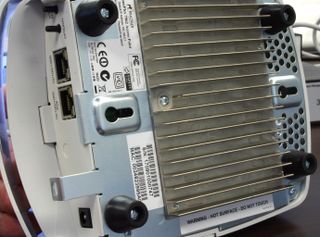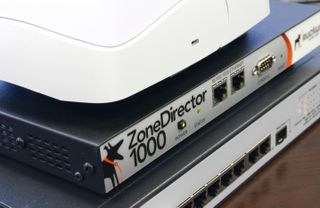Beamforming: The Best WiFi You’ve Never Seen
Test Gear: Ruckus 7962
Keeping in mind that the hardware you’d be most likely to buy would be consumer versions of the enterprise gear we tested, we wanted to approach this as a comparison of technologies more than a review of any given product.
By now, you know a bit about the Ruckus ZoneFlex 7962 access point we evaluated, but let’s take a closer look. Unlike a consumer access point, which is typically built to look cool and enticing, the 7962 is the exact opposite. It’s designed to blend into the woodwork—or, to be more exact, to the ceiling, where it will blend into the white tiling and look a lot like a dome light so as to go unnoticed by would-be thieves and vandals.


Naturally, with 802.11n radios, Gigabit Ethernet, and other electronics running full tilt, the access point can get pretty warm. This is why Ruckus build a heatsink into the bottom.

Under the hood, you can see how radically different the Ruckus design is from conventional access points. Note the circular arrangement of directional antennas.



Once you get up into enterprise-class wireless equipment, deployments generally use a controller device to help manage traffic and coordinate multiple access points. We paired the 7962 with the mid-range Ruckus ZoneDirector 1000 controller running firmware 8.0.1.0 build 13.9

Stay on the Cutting Edge
Join the experts who read Tom's Hardware for the inside track on enthusiast PC tech news — and have for over 25 years. We'll send breaking news and in-depth reviews of CPUs, GPUs, AI, maker hardware and more straight to your inbox.
Current page: Test Gear: Ruckus 7962
Prev Page Can You Hear Me Now? Next Page Test Gear: Cisco Aironet 1142 And Aruba AP125-
pirateboy just what we need, more retarded failnoobs clogging up the airwaves with useless braindead movieclips...yaayReply -
bucifer This article started up pretty good with lots of technical data and the beamforming technology in theory but after that the goodness stopped.Reply
1.You cannot compare two products by testing them with a in-house developed software. It's like testing ATI vs nVIDIA with nvidia made benchmark.
2.If you do something get it done, don't just go with half measures. I don't care if you didn't have time. You should have planned this from the beginning. The tests are incomplete, and the article is filled with crap of Rukus and Cisco. -
Mr_Man In defense of your wife, you didn't HAVE to use that particular channel to view all the "detail".Reply -
@Mr_Man: With a name like yours, I'd think that you'd sympathize with Chris a bit more :P Unless (Mr_Man == I likes men) :DReply
-
Pei-chen Both Tyra and Heidi have personal issues and would be pretty difficult friend/mate.Reply
The network idea sounds better. I couldn’t get my 10 feet g network to transmit a tenth as much as my wired network without it dropping.
-
zak_mckraken There's one question that I think was not covered by the article. Can a beamformaing AP can sustain the above numbers on two different clients? Let's say we take the UDP test at 5 GHz. The result shows 7.3 Mb/s. If we had two clients at opposite sides of the AP doing the same test, would we have 7.3 Mb/s for each test or would the bandwidth be sliced in 2?Reply
The numbers so far are astonishing, but are they realistic in a multi-client environnement? That's something I'd like to know!
Most Popular

